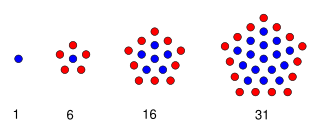有形數是可以排成有一定規律形狀的數。有形數是畢達哥拉斯學派的關注重點之一,他們認為數和形有不可分割的關係。有形數都是自然數,它們可以用小石子堆砌。有形數是將數形象化的方法。
此條目沒有列出任何參考或來源。 (2019年1月9日) |
一般地,任意一個自然數都可以表示為n個n邊形數的和。(此即費馬多邊形數定理)
前幾個平面上的有形數為:(不考慮trivial case,也就是n為n邊形數的情形)
6, 9, 10, 12, 15, 16, 18, 21, 22, 24, 25, 27, 28, 30, 33, 34, 35, 36, 39, 40, 42, 45, 46, 48, 49, 51, 52, 54, 55, 57, 58, 60, 63, 64, 65, 66, 69, 70, 72, 75, 76, 78, 81, 82, 84, 85, 87, 88, 90, 91, 92, 93, 94, 95, 96, 99, 100, ... (OEIS數列A090466)
種類
有形數可依照該數能排成的形狀分成:
例子
能排成三角形的有形數
前17個三角形數是
能排成等腰梯形的有形數
| 2 | 7 | 15 | ||
|---|---|---|---|---|
前15個梯形數為
梯形數公式:(頂層數+底層數)×層數÷2
排成從中心延伸出去的五邊形
前15項的中心五邊形數為
能堆成四角錐的有形數
能排成六角星的有形數
| 1 | 13 | 37 | ||
|---|---|---|---|---|
前13個六角星數是
參見
Wikiwand in your browser!
Seamless Wikipedia browsing. On steroids.
Every time you click a link to Wikipedia, Wiktionary or Wikiquote in your browser's search results, it will show the modern Wikiwand interface.
Wikiwand extension is a five stars, simple, with minimum permission required to keep your browsing private, safe and transparent.


